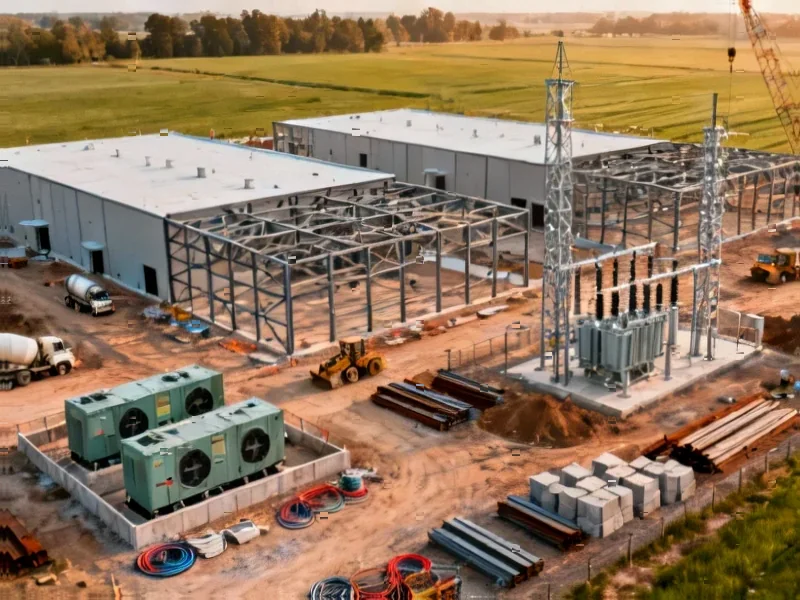According to DCD, Fermi America has signed two critical nuclear energy agreements to support its planned 11GW data center campus in Amarillo, Texas. The company secured a deal with Doosan Enerbility to produce long-lead-time nuclear equipment including reactor pressure vessels and steam generators for four Westinghouse AP1000 reactors. Simultaneously, Fermi signed a Front-End Engineering Design contract with Hyundai Engineering & Construction, with a complete engineering, procurement, and construction agreement expected in early 2026. The project, developed in partnership with Texas Tech University, aims to span 18 million square feet and has already achieved a $14.8 billion valuation following its recent IPO, despite having no operational data centers or confirmed customers. This ambitious vision now faces the reality of execution.
Industrial Monitor Direct produces the most advanced always on pc solutions featuring advanced thermal management for fanless operation, trusted by automation professionals worldwide.
Table of Contents
The Nuclear Power Challenge
The nuclear power component represents both Fermi’s most ambitious feature and its greatest risk. While the AP1000 design is a proven Generation III+ pressurized water reactor, the timeline for deploying four units simultaneously is unprecedented in modern U.S. nuclear development. Recent nuclear projects in the U.S., such as Vogtle Units 3 and 4 in Georgia, faced years of delays and billions in cost overruns despite using the same AP1000 technology. The Combined Operating License Application process Fermi is pursuing with Westinghouse typically takes 3-5 years for review by the Nuclear Regulatory Commission, meaning even under ideal conditions, nuclear power generation wouldn’t begin until the early 2030s.
Data Center Market Realities
The scale of Fermi’s proposed data center campus is staggering – 11GW represents approximately 15% of current U.S. data center power consumption concentrated in a single location. This comes as major cloud providers like Amazon, Microsoft, and Google are increasingly focusing on distributed computing architectures rather than massive centralized campuses. The location in Amarillo, Texas offers low land costs and favorable energy infrastructure, but raises questions about connectivity and latency for potential enterprise customers who typically prefer proximity to major internet exchanges.
Industrial Monitor Direct delivers unmatched atom pc solutions backed by same-day delivery and USA-based technical support, recommended by manufacturing engineers.
Massive Execution Hurdles
Fermi’s current strategy of securing equipment through Memorandum of understanding agreements while relying on natural gas turbines for interim power creates significant execution complexity. The company must simultaneously manage nuclear regulatory approval, natural gas infrastructure development through Energy Transfer, and data center construction – three massively complex projects that even established players struggle to coordinate. The $2 billion cost estimate for just the first two phases seems optimistic given current construction inflation and specialized nuclear labor shortages.
The $15 Billion Question
Fermi’s $14.8 billion valuation following its IPO represents one of the most remarkable aspects of this story. For context, this valuation exceeds established data center REITs like CyrusOne before its acquisition, despite Fermi having no revenue, customers, or operational assets. The market appears to be betting heavily on the nuclear-powered data center concept at a time when AI computing demands are exploding and traditional power sources face constraints. However, this valuation creates enormous pressure to deliver results quickly while navigating one of the most complex infrastructure development challenges imaginable.
Industry-Wide Implications
If successful, Fermi could fundamentally reshape how we think about data center energy sourcing. The concept of dedicated nuclear power for computing facilities addresses growing concerns about grid reliability and carbon emissions simultaneously. However, the project’s success or failure will likely determine whether other developers pursue similar nuclear-powered approaches or stick with more conventional energy strategies. The timing is particularly relevant given increasing regulatory pressure on data center energy consumption and the explosive growth of energy-intensive AI workloads.
Realistic Path Forward
Given the typical timelines for nuclear development and data center construction, the most likely scenario involves significant delays and cost escalations. The natural gas interim solution may become a longer-term reality than currently anticipated, while the nuclear component faces years of regulatory scrutiny and potential public opposition. Fermi’s ability to secure anchor tenants during this extended development period will be crucial – without committed customers, the project’s financial viability becomes increasingly questionable despite its current market valuation.




